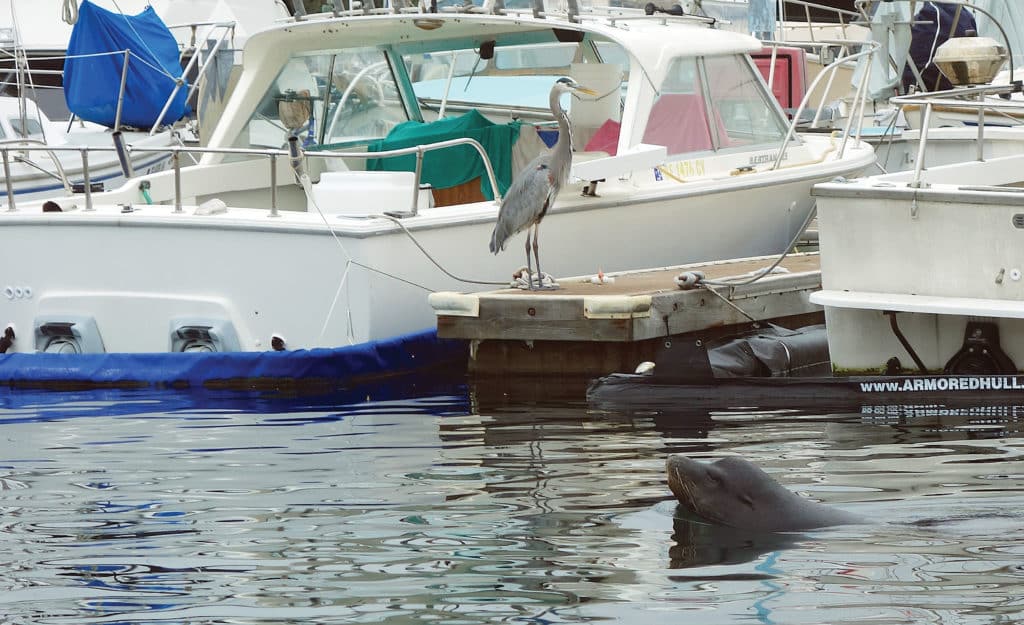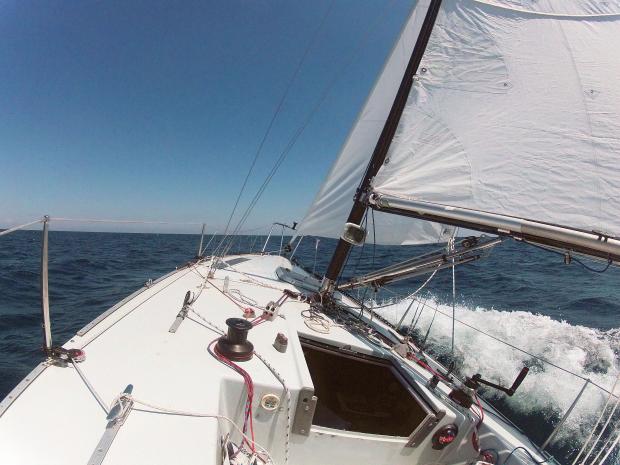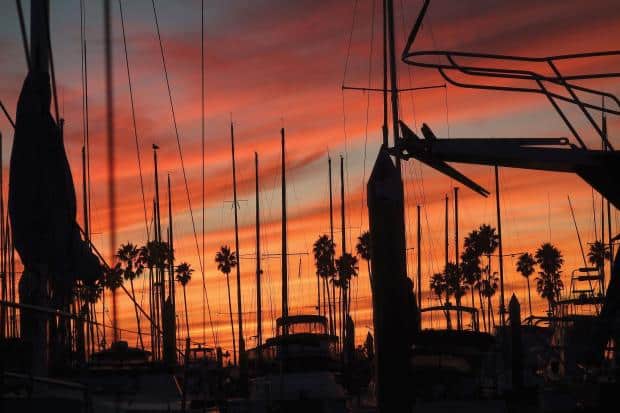
A sea lion flopped onto the end of a dock near Gannet‘s new slip, and a white egret landed on another just as I was about to leave. I lingered long enough to startle the egret. I don’t want messy birds, however elegantly formed, to make Gannet their home. Egret flapped off; sea lion reclined with eyes comfortably closed; I pushed the little sloop out, stepped aboard and whirred into Mission Bay’s Quivira Basin, where I had lived aboard in the late 1960s and from which I began my open-boat voyage in 1978.
That October day in 2012, Gannet had been in San Diego two weeks, following a tow from near Chicago. Thanks to a tracking device, I saw that just before midnight on Oct. 11 she passed within a mile of the suburban house in Kirkwood, Missouri, where as a teenager more than a half-century earlier I sat in my room, staring out over an empty field and dreaming of the ocean. Nice touch, life.
It had taken me a long time that morning to reconfigure Gannet‘s cabin from dock to sailing mode. I have come to realize that her interior is a puzzle of interlocking parts, which must be arranged and rearranged in specific order. I am getting better at that and at stowing objects I often need within arm’s reach of Central, as I call the aft-facing Sport-a-Seat on the Great Cabin floor, which is the only place that I, at 6 feet 1 inch, can sit unbent. However, when I cleared the pipe berths so that I could later sleep on them, the puzzle was in disarray.
Just outside the basin I set the sails and tacked out between breakwaters.

No other boats were on the water. It was a weekday, but I found when I previously lived in San Diego that boat use mostly ends, even in so pleasant a climate, on Labor Day.
About halfway out the channel I caught a finger on the exposed end of a split ring — a minor injury, but copious blood. I was wearing old clothes and kept the finger pressed to my Levis, sailing truly singlehanded until I got out in the ocean, set the tiller pilot and went below for a Band-Aid.
The wind was from the west-northwest and light. Gannet spent the day close-hauled on port tack, mostly making a pleasant 5 knots, occasionally 6, with a little spray over the bow.
From the sea, Mission Beach looked just as it had when I sailed off it 40 years ago: waves curling onto a 2-mile gradual arc of sand; low homes and condos; blue sky; sparkling water.
As the day continued, the wind veered and headed us, until at sunset we were converging with dramatic purple mountains near San Clemente. At last light I tacked, then eased off to a close reach for more comfortable sleeping.
For the first hours of the night the half moon reflecting on a smooth ocean was lovely. Then the moon set and the wind died. Gannet‘s boom bounced around, causing me to realize I hadn’t yet rigged a preventer.
Overall I slept well, waking many times, seeing the lights of a few other vessels, but none near. The new lee cloths did their job. At one time while awake I found myself thinking that leaving both pipe berths empty so I can move my weight to whichever is to windward is inefficient, and that it might be better to stow heavy objects, such as water jerry cans, on the port berth, whose space is compromised by spare lines tied to a tube near the overhead anyway, and just sleep to starboard.

Dawn found us 34 miles northwest of my waypoint off the Mission Bay jetties.
After breakfast, I set the asymmetrical with Facnor furling gear on the Forte carbon-fiber bowsprit for the first time. It all went smoothly. I did several jibes just for practice.
As we neared La Jolla, I jibed again and remembered why I have removed snap shackles from my previous boats when the one on the asymmetrical’s port sheet caught on the furled jib, opened and dropped into the water. I pulled the line aboard, furled the asymmetrical, set the jib and proceeded to remove snap shackles from the sheets and unused halyards. Bowlines don’t come undone; at least mine never have.
With the smaller headsail our speed dropped and so did the wind until we were approaching the slip, and then it only increased to 9 knots.
Gannet is an ultralight.
I cut the Torqeedo but under bare poles we were still making 1.8 knots — far too fast. I used reverse to slow us, but knew that Gannet carries no way and when I turned into the wind she would be stopped. She was.
When Gannet was in the Midwest I suffered from a disease for which I invented a Latin name: captiaterraphobia: fear of being trapped by land.
I was cured. We had returned to sea lions and the sea.
This article first appeared in the January 2014 issue of Cruising World.








